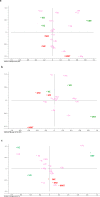The impact of fungicide treatments on yeast biota of Verdicchio and Montepulciano grape varieties
- PMID: 31220090
- PMCID: PMC6586281
- DOI: 10.1371/journal.pone.0217385
The impact of fungicide treatments on yeast biota of Verdicchio and Montepulciano grape varieties
Abstract
Yeast species that colonize the surface of grape berries at harvest time play an important role during the winemaking process. In this study, the use of culturable microbial techniques permitted a quantitative and qualitative inventory of the different yeast species present on the grape berry surfaces of Montepulciano and Verdicchio varieties when treated with conventional and organic fungicides. The results show that the most widespread yeast species at harvest time were Aureobasidium pullulans and Hanseniaspora uvarum, which are considered normal resident species and independent of the grape varieties and treatments applied. Specific differences when comparing the grape varieties were observed in species and were detected at a lower frequency; Pichia spp. were prevalent in Verdicchio, whereas Lachancea thermotolerans and Zygoascus meyerae were found in Montepulciano. In both vineyards, the farming treatments improved the competitiveness of A. pullulans, which was probably due to its reduced susceptibility to treatments that improved the competition toward other fungi. In contrast, the fermenting yeast H. uvarum was negatively affected by fungicide treatments and showed a reduced presence if compared with untreated grapes. Organic treatments directly impacted the occurrence of Issachenkia terricola in Montepulciano grapes and Debaryomyces hansenii and Pichia membranifaciens in Verdicchio. Conversely, a negative effect of organic treatments was found toward Metschnikowia pulcherrima and Starmerella bacillaris. Overall, the data suggest that the yeast community colonizing the grape berry surface was influenced by both grape variety and farming treatments, which characterized the yeast biota of spontaneous must fermentation.
Conflict of interest statement
The authors have declared that no competing interests exist.
Figures





Similar articles
-
The microbial ecology of wine grape berries.Int J Food Microbiol. 2012 Feb 15;153(3):243-59. doi: 10.1016/j.ijfoodmicro.2011.11.025. Epub 2011 Dec 2. Int J Food Microbiol. 2012. PMID: 22189021
-
Quantitative and qualitative composition of yeast microbiota in spontaneously fermented grape musts obtained from cool climate grape varieties 'Rondo' and 'Regent'.FEMS Yeast Res. 2018 Dec 1;18(8). doi: 10.1093/femsyr/foy089. FEMS Yeast Res. 2018. PMID: 30184086
-
Grape berry yeast communities: influence of fungicide treatments.Int J Food Microbiol. 2013 Feb 15;161(3):240-6. doi: 10.1016/j.ijfoodmicro.2012.12.019. Epub 2013 Jan 2. Int J Food Microbiol. 2013. PMID: 23337124
-
Yeasts found in vineyards and wineries.Yeast. 2017 Mar;34(3):111-128. doi: 10.1002/yea.3219. Epub 2016 Dec 6. Yeast. 2017. PMID: 27813152 Review.
-
Microbial terroir and food innovation: The case of yeast biodiversity in wine.Microbiol Res. 2015 Dec;181:75-83. doi: 10.1016/j.micres.2015.10.005. Epub 2015 Oct 19. Microbiol Res. 2015. PMID: 26521127 Review.
Cited by
-
Year, Location, and Variety Impact on Grape-, Soil-, and Leaf-Associated Fungal Microbiota of Arkansas-Grown Table Grapes.Microb Ecol. 2021 Jul;82(1):73-86. doi: 10.1007/s00248-021-01698-8. Epub 2021 Jan 29. Microb Ecol. 2021. PMID: 33515050
-
Yeast communities related to honeybees: occurrence and distribution in flowers, gut mycobiota, and bee products.Appl Microbiol Biotechnol. 2024 Jan 26;108(1):175. doi: 10.1007/s00253-023-12942-1. Appl Microbiol Biotechnol. 2024. PMID: 38276993 Free PMC article.
-
Year, Location, and Variety Impact on Grape-Associated Mycobiota of Arkansas-Grown Wine Grapes for Wine Production.Microb Ecol. 2021 Nov;82(4):845-858. doi: 10.1007/s00248-021-01705-y. Epub 2021 Mar 5. Microb Ecol. 2021. PMID: 33665722
-
Ethanol Reduction in Montepulciano Wine: Starmerella bombicola Sequential Fermentation at Pilot Scale Under Aeration Conditions.Foods. 2025 Feb 13;14(4):618. doi: 10.3390/foods14040618. Foods. 2025. PMID: 40002062 Free PMC article.
-
Impact of Chemical and Alternative Fungicides Applied to Grapevine cv Nebbiolo on Microbial Ecology and Chemical-Physical Grape Characteristics at Harvest.Front Plant Sci. 2020 May 29;11:700. doi: 10.3389/fpls.2020.00700. eCollection 2020. Front Plant Sci. 2020. PMID: 32547588 Free PMC article.
References
-
- Fleet GH, Prakitchaiwattana C, Beh AL, Heard G. The yeast ecology of wine grapes. Biodiversity and biotechnology of wine yeasts. Research Signpost, Kerala, India; 2002. 95, pp. 1–17.
MeSH terms
LinkOut - more resources
Full Text Sources
Miscellaneous

